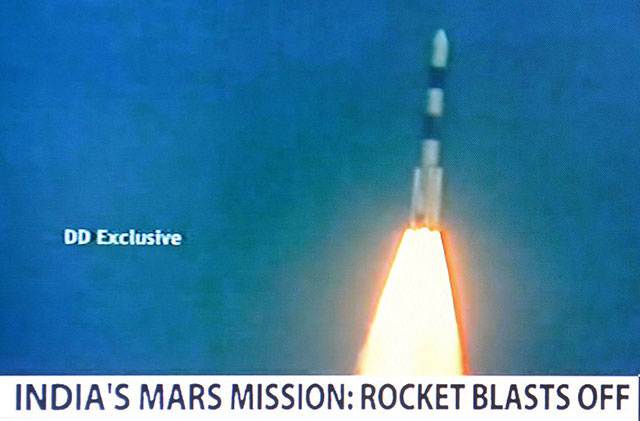SUMMARY
This is AI generated summarization, which may have errors. For context, always refer to the full article.

BANGALORE, India – India’s first mission to Mars left Earth’s orbit Sunday, December 3, successfully entering the second phase of its journey that could see New Delhi win Asia’s race to the Red Planet, scientists said.
The spacecraft, called Mangalyaan, now embarks on a 10-month journey around the sun before reaching Mars in September next year, the state-run Indian Space Research Organisation (ISRO) said.
“The spacecraft is on course to encounter Mars after a 10-month journey around the sun,” ISRO said in a statement.
“Following the completion of the latest maneuver, the Earth orbiting phase of the spacecraft has ended,” it said.
But Mangalyaan, which is traveling at a speed of 32 kilometers (20 miles) per second, could still face hurdles before India joins an elite club of countries to have reached Mars.
India has never before attempted to travel to Mars and more than half of all missions to the planet have ended in failure, including China’s in 2011 and Japan’s in 2003.
So far, only the United States, European Space Agency and Russia have been able to send their probes to Mars.
NASA launched its unmanned MAVEN spacecraft toward Mars on November 18 to study the Red Planet’s atmosphere for clues as to why Earth’s neighbor lost its warmth and water over time.
India’s Mangalyaan blasted off on November 5 and is using an unusual “slingshot” method for interplanetary journeys.
Lacking enough rocket to blast directly out of Earth’s atmosphere and gravitational pull, it was orbiting the Earth until the end of November while building up enough velocity to break free.
ISRO chairman K. Radhakrishnan hailed Sunday’s successful operation to slingshot out of Earth’s orbit as a “major step” forward in India’s low-cost space program.
“(It is) a turning point for us, as India will foray into the vast interplanetary space for the first time with an indigenous spacecraft to demonstrate our technological capabilities,” Radhakrishnan told Agence France-Presse.
The cost of the project, at 4.5 billion rupees ($73 million), is less than a sixth of the $455 million earmarked for NASA’s Mars probe.
Two of the three phases of the Indian Mars mission have now been accomplished, according to ISRO’s spaceport director M.Y.S. Prasad.
“The third important phase will be the capturing of Martian orbit in September 2014 for the five scientific experiments,” Prasad told AFP from the spaceport of Sriharikota in the southern state of Tamil Nadu.
Mangalyaan is carrying a camera, an imaging spectrometer, a methane sensor and two other scientific instruments to search for signs of life on the Red Planet.
The Mars Orbiter Mission or Mangalyaan was revealed only 15 months ago by Prime Minister Manmohan Singh, shortly after China’s attempt flopped when it failed to leave Earth’s atmosphere.
The timing and place of the announcement – in an Independence Day speech – led to speculation that India was seeking to make a point to its militarily and economically superior neighbor, despite denials from ISRO. – Rappler.com
Add a comment
How does this make you feel?
There are no comments yet. Add your comment to start the conversation.